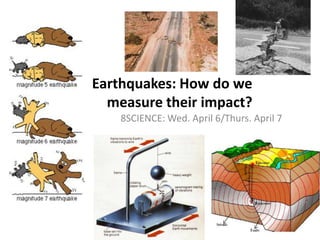
Earthquakes how measureimpact
- 1. Earthquakes: How do we measure their impact? 8SCIENCE: Wed. April 6/Thurs. April 7
- 2. Review: Forces and Faults What are 3 types of forces responsible for earthquakes? Compression Tension Shear What faults are associated with each type of force? Describe. Compression – reverse fault Tension – normal fault Shear – strike – slip fault Reverse
- 3. Energy and Seismic Waves Seismic waves Created by the earthquake When rocks move and break along a fault, energy is released and this creates damage Energy is released from the focus, located under the surface of the Earth This energy travels away from the focus as seismic waves
- 4. Seismic Waves Primary waves (P – waves) Make rocks vibrate back and forth Fastest waves at about 6km/second Secondary waves (S – waves) Shake rocks from side to side Half the speed of P waves about 3 km/second Energy that reaches the surface is in the form of waves called surface waves Cause the most damage but are the slowest
- 5. Surface Waves The point on the Earth’s surface directly above an earthquake’s focus is the epicenter Surface wavestravel outward from the epicenter and move up, down and side to side Can cause buildings to move in different directions and fall apart
- 6. How do we measure the strength of an earthquake? Scientists (seismologists) use the different speeds of the seismic waves to find the distance to the epicenter of the earthquake A seismograph measures the energy released, or magnitude of the earthquakes Which types of waves arrive first to a station? 1)Primary2)Secondary3)Surface
- 7. How do we measure the strength of an earthquake? Earthquake magnitude is usually measured using the Richter scale 1.0 – 9.0 Each 1 step increase = 10 x strongerEx: From 6.0 to 8.0 = 100x